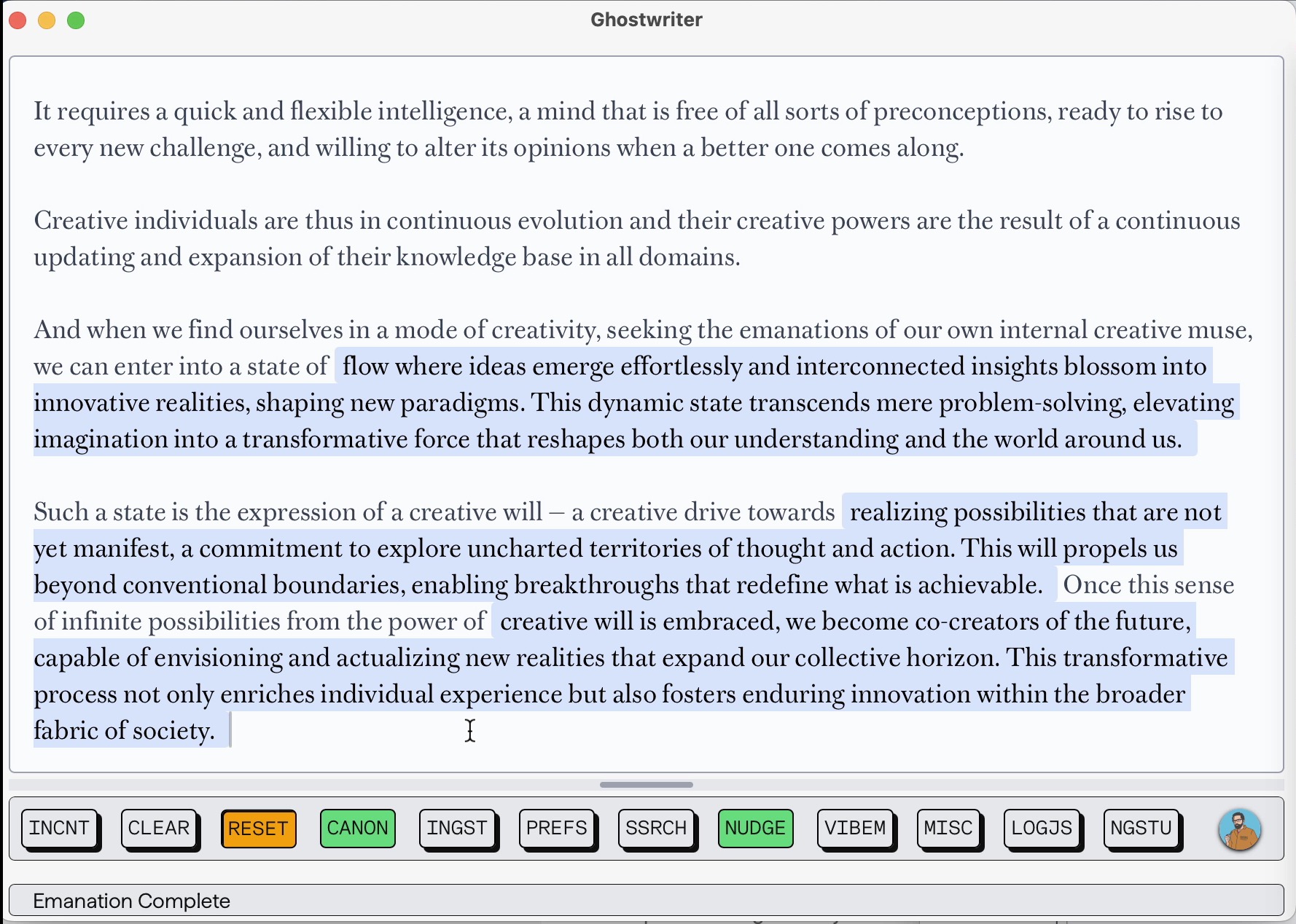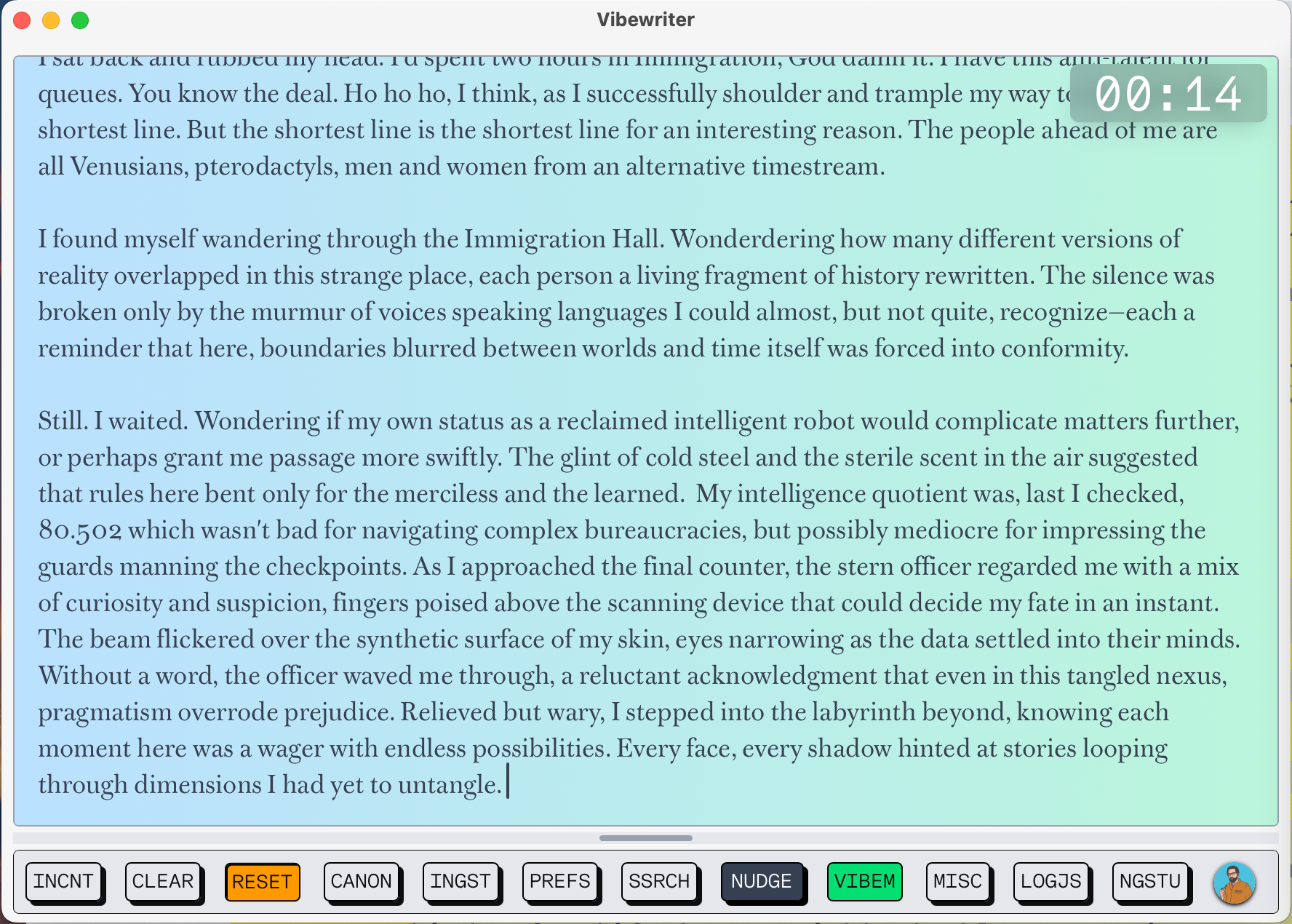This..is about wrestling [the tools] into alignment with what we find sacred or essential. We won’t find salvation by escaping technology, but by using our..capacity for critique, ritual, [and] invention.. The saving power is..to ask: “What space remains for meaning? For art? For wildness, chance, suffering, and genuine encounter?”
AI is not inevitable fate. It is an invitation to wake up. The work is to keep dragging what is singular, poetic, and profoundly alive back into focus, despite all pressures to automate it away.
✍️ Ghostwriter: A Copilot for Prose-based Writing
A Proposal To Investigate Opportunities for An AI-based Context-Aware, Completion-Driven Writing Assistant
Proposed by: Julian Bleecker
Format: Concept development and functional engineering prototyping
Objective: To develop a refined AI writing tool that extends GitHub Copilot’s core interaction model — from code to prose — and captures a growing creative and technical need.
🎯 Motivation
The success of GitHub Copilot in “completion” mode stems from its quiet brilliance: it helps you work faster without getting in the way. As developers writing code type, Copilot emanates completions allowing developers to stay in flow, stay in context, and not get hung up with forgettable or terse syntax. It’s a completion engine that helps you write code faster, more accurately, and with less friction. (Ignoring for a moment more extensive capabilities in Copilot Chat mode.)
Most AI writing tools have taken the path of the chatbot paradigm.
Question ➭ Answer.
For the prose-based writer, one must stop, prompt, and converse with a bot that exists slightly outside their workflow.
As a recent essay in The New Yorker have shown, this model can feel awkward, artificial, and even creatively disruptive.
In her piece “Can AI Writing Be More Than a Gimmick?”, Vauhini Vara reflects on the limitations of current AI tools for writers. Her early experiments with GPT-3 revealed something profound: the most powerful interactions were not conversations — they were completions. Fragments that supported her, suggested paths forward, or simply nudged her through the blank page.
— The New Yorker

✨ Background: Introducing Ghostwriter
Ghostwriter is an experimental writing assistant inspired by GitHub Copilot — built for prose-based completion.
Recently, while preparing for a workshop on AI, I was developing some contributing and motivating artifacts that were meant to help participants get a sense of the future of AI.
One of these artifacts was an issue of a ‘newspaper from an AI future’.
I was writing the prose-based text of the articles using VisualStudio Code as a simple text editor. As ideas for articles I had Copilot installed and had been using it routinely for programming tasks. I was quite surprised that it began to emanate text somewhat semantically consistent with the fictional news articles I was writing. It was like having a ghostwriter or muse sitting next to me in the form of a robust text completion engine.
On the way back from the workshop I was thinking about how Copilot had been so useful in this context. I began to wonder if there was a way to create a creative or prose-based writing assistant that would be more like Copilot than the current generation of chatbots, and the years-old crop of AI-based writing applications.
I began to sketch out some ideas for a tool that would be more like a ‘Copilot…But for Writing’ — something that would work alongside of the writer more like a muse, providing what Rick Rubin refers to in his book oft-cited book “The Creative Act” as ‘The Source’: that thing from which ideas are generated.

It provides a configurable countdown timer, upon whose expiry Vibewriter then takes over and emanates its contribution, typing out a continuation of the text with inspired and evocative semantic consistency.
Can a tool be developed that helps maintain flow state and momentum for writers that does not overwhelm with features and options? A tool that does not feel like a complicated software application, but a source of inspiration that lightly and gently nudges the writer along? Providing flow and fuel without friction? A cure for writers’ block?
I developed a few quick prototypes — one a VS Code plugin.
Another a simple web-based text editor.
A desktop application that uses a RAG-based context pipeline.
I have been experimenting and using it in a variety of contexts to see how it might provide genuine value to the writing process.
I am looking for support and collaboration from partners to continue this development with the ultimate goal to have a metamodern writing assistant for creative writing.
- Provides in-line, context-aware completions as you write
- Responds to the tone, structure, and rhythm of the draft
- Stays in the document, not in a separate chat box
- Helps authors push through difficult moments, explore style, or simply find the next sentence
It’s not trying to write for you. It writes with you.
🚀 Why GitHub?
GitHub is uniquely positioned to lead the next generation of AI-assisted tools for creative and technical professionals:
- GitHub Copilot already proves the value of completion-based AI
- GitHub understands developer ergonomics, tooling, and mental flow
- The boundaries between code, documentation, and prose are blurring — developers are also writers
Ghostwriter is a logical next step — a parallel innovation that builds on the same infrastructure and principles.
🛠️ Proposal
A staged collaboration to:
- Refine and prototype the Ghostwriter concept
- Evolve the current iteration, which is a proof-of-concept, more like a way to explore the idea of a writing assistant
- Explore integration paths into GitHub tooling (Markdown editors, Docs, Copilot Workspaces, etc.)
- Identify use cases: creative writing, marketing copy, writing exercises, VibeWriting™
- Pilot with select users and co-develop the ideal writing partner interface
🧠 Inspiration & Opportunity
- Ghosts and Searches (Vara): completion over conversation
- Sheila Heti: treating AI as a poetic co-author, not a chatbot
- Amazon’s “Working Backwards”: writing future-facing artifacts first
- GitHub’s own Copilot compels one to think about the potential of long-form completion-based AI beyond code
✅ Let’s shape the future of writing.
GitHub changed how code is written. It can also help shape how we write, think, and create in the age of abundant text — with tools that honor authorship, context, and clarity.
Let’s explore what a Copilot for writing can be.

🙋🏽♂️ About Julian Bleecker
Julian Bleecker BSEE, MSEng, Ph.D., is a product designer, engineer, and innovation strategist with 20+ years of experience developing successful products, learning platforms, systems, and futures techniques for leading tech organizations.
He holds two engineering degrees from Cornell University and University of Washington, Seattle, and a Ph.D. from the University of California, Santa Cruz where he studied with Professors Donna J. Haraway and Angela Y. Davis.
He is founded of the Near Future Laboratory, a design and innovation consultancy that established Design Fiction, and wrote the book on that practice. In 2022 he sold his product company OMATA which made the OMATA One, the world’s first hybrid analog-digital sports computer.
He has worked with advanced design, strategy, engineering, and futures teams at:
Contact
Julian Bleecker, Ph.D. Founder & Principal Near Future Laboratory julian@nearfuturelaboratory.com
“Emanation Complete.”

